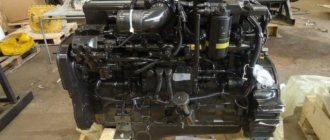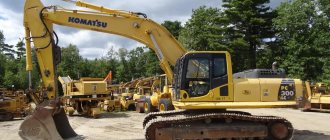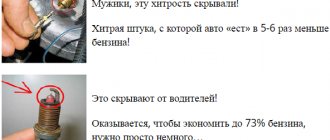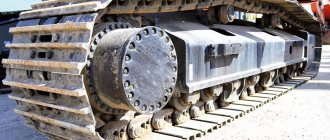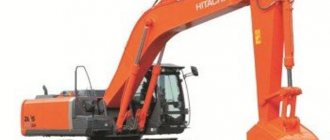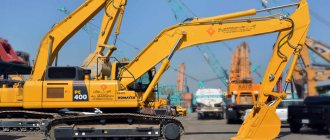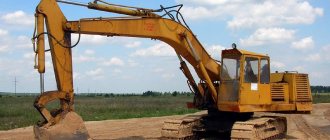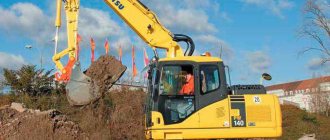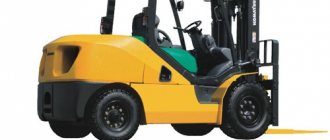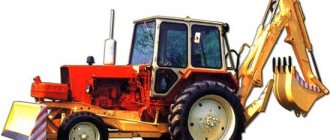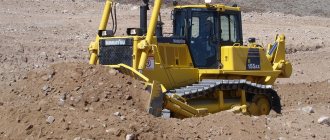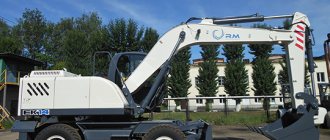Komatsu PC300 is a crawler excavator designed for a wide range of jobs. Special equipment is used for digging trenches, pits, as well as loading and unloading bulk materials. The model is the flagship in the line of the Japanese manufacturer, which has been supplying special-purpose equipment and units to the world market for almost a century. Thanks to its technical performance, power, reliability and operational stability, the machine has held a leading position in sales in many countries around the world for many years.
Click to enlarge.
The PC300 belongs to the middle class in the category of tracked special equipment. The ability to connect a variety of attachments allows it to be used in a variety of areas, namely:
- In the construction field for creating pits for pouring foundations.
- In creating trenches for laying gas and oil pipelines.
- For opening the soil during various types of repair and restoration work.
- In the formation of soil embankments.
- In the development of mineral resources.
- For transporting a wide variety of heavy loads within a small area.
- In the processing of construction sites.
- When creating artificial reservoirs.
- To perform loading and unloading operations.
Komatsu PC300 excavator design
The base of the excavator is a frame made of high-strength steel alloy. At the same time, all the components of the machine are correctly distributed throughout its design. Work with massive loads is ensured by the reinforced handle and bucket of the equipment.
Major components such as the power unit, hydraulics and fuel system are manufactured directly at the Komatsu plant. All critical mechanisms are characterized by a large margin of strength and durability, and special protection is provided for individual components. For example, all working cylinders are protected by particularly wear-resistant rings.
The latest electronic control systems from leading Japanese manufacturers make the PC300 invulnerable even in the most extreme Russian operating conditions.
Pros and cons of Komatsu PC300
The excavator received recognition as the best in its series thanks to such features as:
- trouble-free operation;
- high power;
- high cross-country ability;
- maneuverability;
- convenience and ease of operation;
- safety in use;
- low soil penetration coefficient;
- optimal price/quality ratio.
The machine has one drawback, which is typical for all types of similar equipment, and that is the inability to move independently over long distances. Therefore, to deliver it you need to order a tractor.
Specifications
| Model | Komatsu PC300-7 | Komatsu PC300-8 | Komatsu PC300-8M0 |
| Power, (hp) | 245 | 260 | 260 |
| Operating weight, (kg.) | 31 510 | 34 200 | 31 100 |
| Bucket (cubic m) | 2,2 | 1,9 | 1,4/1,6/1,8 |
| Engine type | SAA6D114E | SAA6D114E | SAA6D114E |
| Track width, (mm) | 600/700/800 | 700 | 600 |
| Ground pressure, (kg/cm 3) | 0,64/0,54/0,46 | 0,64 | 0,64 |
| Max. digging depth, (mm) | 6920 | 6310 | 7380 |
| Max. digging height, (mm) | 9580 | 9525 | 10100 |
| Transport length, (mm) | 11 290 | 10 710 | 11 150 |
| Overall height, (mm) | 3 130 | 3 145 | 3 285 |
| Overall width, (mm) | 3 190 | 3 290 | 3 190 |
| Handle length, (mm) | — | 6 000 | 3 185 |
| Boom length, (mm) | 6 470 | 2 550 | 6 470 |
Over the entire period of production of the line of excavators, the plant has produced many versions, differing only in technical parameters. The main range of modifications of the line is represented by Komatsu models: PC300-2, PC300-3, PC300-4, PC300-5, PC300-6, PC300-7, PC300-8 and PC300-8MO.
Analogues of Komatsu PC300
The analogues of this excavator in terms of technical characteristics include the following models: Zeus HXW310, Fiat Kobelco EX 355, KATO HD1430, Caterpillar EL300B, Hitachi ZX330, Hitachi EX300, Doosan dx300lca. However, in terms of reliability and price/quality ratio, few can compete with this model of the Japanese excavator, which is why it has become so widespread.
Specifications
The maximum pressure per 1 cm² of soil is 0.64 kg. Platform rotation speed – 9 rpm. The Komatsu PC300 weighs 30.8 tons.
Performance characteristics of the equipment
- maximum bucket force – 26400 kgf;
- maximum digging depth – 7.38 m;
- maximum unloading height – 6.6 m;
- maximum digging height – 10.2 m;
- digging radius – 10.2 m;
- bucket volume – 1.4 m3.
Dimensions of Komatsu RS 300
The machine is 11.3 m long, 3.2 m wide, 3.1 m high, has a maximum platform turning radius of 3.5 m, a 2.2 m long handle and a 6.47 m long boom. The maximum travel speed is 5.5 km / h, and ground clearance is 0.5 m.
Fuel consumption
On average it is 18-28 l/h depending on the operating mode. The fuel tank is designed for 605 liters.
Prices for Komatsu RS200-8
The price varies depending on whether we are talking about new special equipment or something that has already been in operation. If this is a brand new excavator, then you will have to pay from 5 to 6 million rubles for it. The exact amount depends on the year in which the special equipment was produced, and it is also determined by what additional equipment is present on this vehicle.
If we are talking about an excavator that has been in operation for some time, then the amount it will cost the buyer depends on how long it has been in operation. So, if he carries out operations for about a thousand engine hours, then he should focus on a price of 4 to 5 million, but if he worked for over five thousand engine hours, then in the range of 3 to 4 million. In addition, the cost of a used Komatsu PC200-8 is influenced by the year of its manufacture, and it is also determined by its actual technical condition.
Device
This excavator model is durable and reliable, which is guaranteed by:
- installation of metal safety rings. They are designed to protect hydraulic cylinders, while increasing the reliability of the machine;
- the strength of all elements and installations that pass all tests at the manufacturing plant;
- electronics installations. It is not exposed to harsh working conditions, because... passed all necessary endurance tests;
- installation of equipment and devices of increased precision. With a reinforced bucket and arm and a developed cross-section, the machine is able to increase productivity if necessary. In addition, welding is performed continuously with edge preparation. This gives additional strength to the entire structure;
- reinforced frame design. Durability is due to automation of production and due to the inclusion of emission microscopy at the design stage.
The special equipment of the largest Japanese corporation Komatsu has long received worldwide recognition. Reliable and unpretentious cars attract consumers with a convenient control system, economical fuel consumption and an affordable price.
Komatsu tracked excavators, which will be discussed below, are among the most popular machines in their class and are distinguished by their ability to work in harsh climatic conditions and improved cross-country ability. In addition, the machines have high efficiency indicators when performing work on loose soils and are able to move quite carefully without compromising the integrity of the road surface.
Offers a wide variety of models of tracked equipment. In the middle class, excavator models such as the PC300 and PC400 are in great demand. These machines can rightfully be called universal, since they are used to perform a wide range of tasks.
Cabin
The cabin has a height of 2095 millimeters, the width of this structure is 2710 mm.
The cabin of the special equipment is decorated with materials with increased noise insulation, which cover the internal surfaces of its doors. Thanks to this, the operator servicing the excavator does not suffer from the noise it produces during operation. Thus, it can work in absolute comfort even when the work is relatively long-term.
The Komatsu RS200-8 operator's chair is equipped with armrests, its location can be adjusted, and this element can also be moved. In this case, the chair can be moved around the cabin together with the joysticks that control the cabin, as well as separately without joysticks.
Minimization of vibration reaching the operator is achieved through a spring-hydraulic mechanism of a multi-layer structure, as well as a sprung platform. It is allowed to install an air conditioner and a radio together with a radio inside the cabin.
The cabin is characterized by a relatively large window size and, accordingly, a significant glazing area. In this way, an increase in visibility is achieved for the person in the cockpit, making it easier for him to monitor what is happening from all sides around him.
Also, a sliding window is inserted into the doors and roof of the Komatsu PC200-8, which during operation the operator can lock in a certain position to ventilate the room. At the same time, when the windows are closed, the interior has very high airtightness, and dust will not get inside.
In addition, the cabin has a locking mechanism for various controls, including levers. With its help, it is ensured that a worker climbing into the cabin will not accidentally press one of the levers, starting any mechanism. The operator will need to disable this locking mechanism to begin operation.
Information for the operator in the cab is displayed on modern small-sized displays.
Excavator Komatsu RS 300: technical characteristics
The Komatsu PC 300 excavator is equipped with an original 6-cylinder unit from the manufacturer SAA6D114E-3. The engine capacity is 8.3 liters and the power is 260 hp/194 kW. The equipment reaches a maximum speed of 5.5 km/h.
Performance characteristics
Bucket volume - 1.4 m3.
Digging height (max.) - 9.6 m.
Unloading height (max.) - 6.6 m.
Digging radius (max.) - 10.2 m.
The maximum bucket force is 26,400 kgf.
The maximum force on the handle is 24,000 kgf.
dimensions
Length - 11.3 m; width - 3.2 m; height - 3.1 m.
Handle length - 2.2 m.
Ground clearance: minimum - 0.5 m; counterweight - 1.2 m.
The turning radius of the platform is 3.5 m.
Advantages of the Komatsu RS 300 excavator
- Increased power with low fuel consumption.
- Traction force has increased by almost 20% compared to the previous model.
- Productivity is increased by increasing the pressure force of the bucket and arm.
- Improved lateral stability, which increases the load-carrying capacity of the equipment.
- Extended replacement period for special fluids and fuels.
- Simplified maintenance system.
The RS 300 working equipment is made of high-strength steel, and the structure itself is significantly strengthened for greater reliability. The manufacturer guarantees the reliability of the excavator frame and power units. At the same time, Komatsu did not forget about operator comfort. The cabin is designed for maximum ease of control of the equipment:
- equipped with air conditioning;
- provides a wide all-round view;
- has vibration dampers and sound insulation.
Peculiarities
One of the features is a fuel saving system, with the use of which a person using special equipment can consume 20% less fuel than without it. This system provides that if there is no movement of the levers of special equipment for four seconds, the excavator engine is switched to idle. If the levers are subsequently touched, then the motor switches back to standard operating mode.
This system gives a very noticeable effect, since in practice the Komatsu PC200-8 engine needs to develop maximum speed values only for short periods; most of the time they are unnecessary.
The boom of the special equipment, as well as its handle, are made using welding, which is carried out by a continuous method, which improves the reliability of these units. During operation, the excavator arm moves as precisely as possible.
In addition, the equipment is equipped with a very advanced diagnostic system, which monitors the timing of oil and filter renewals, and also signals when it is time for maintenance.
Maintenance of special equipment is carried out without difficulty, since access to its engine and filters is very easy.
Excavator Komatsu RS 400: technical characteristics
Komatsu PC 400 is powered by a 6-cylinder original SAA6D125E-3 engine. It has a displacement of 11 liters and a power of 347 hp. The maximum speed of the excavator is 5.5 km/h.
Performance characteristics
Bucket volume - 1.9 m3.
Digging height (max.) - 10.3 m.
Unloading height (max.) - 7 m.
Digging radius (max.) - 11 m.
The maximum bucket force is 28,200 kgf.
The maximum force on the handle is 25,900 kgf.
dimensions
Length - 11.9 m; width - 3.3 m; height - 3.9 m.
Handle length - 2.4 m.
Ground clearance: minimum - 0.6 m; counterweight - 1.3 m.
The turning radius of the platform is 3.6 m.
Advantages of the Komatsu RS 400 excavator
- High performance with low fuel consumption.
- Powerful and economical engine.
- High digging force.
- Possibility to use two boom operating modes.
- Increased stability of equipment on slopes and various types of soil.
- Increased lateral stability guarantees a higher load capacity of the PC 400.
Like the previous model, the RS 400 boasts an extended fluid and fuel replacement period, a spacious and comfortable operator's cabin, the presence of protective mechanisms and high durability of the working equipment.
Komatsu excavators are designed for use in the most aggressive conditions. These are powerful and productive machines that rarely break down and last a long time.
Attachments
An excavator is a universal special equipment. This is due to the fact that the machine is equipped with a number of types of attachments. Among other things, the excavator contains:
- The digging bucket is the main element; it is installed on all excavators by default. It is used for digging trenches and pits. In addition, it is used for loading bulk products, as well as for transporting them over short distances. This Komatsu PC200-8 bucket is equipped with several teeth; in general, their number does not exceed six; there are several options with different numbers of teeth. No special adapter is required to install this element. The standard bucket has the following characteristics: volume 800 mm3; the highest available height of unloading it produces is about 7110 millimeters; maximum depth 6620 mm; the minimum radius of movement is 3040 millimeters, and the maximum is 9875; at the edge of the bucket the force reaches 15,200 kilograms*force; the carrying capacity reaches 6750 kilograms.
- The leveling bucket element differs from the previous one by a significantly smaller volume, and it also lacks teeth. Its main function is to carry out leveling work. Such buckets come in different sizes, and the volume they capture varies accordingly. No additional adapter is required to attach them to the handle.
- Hydraulic type breaker. This is one of the key devices; it is designed for carrying out work on dismantling structures. This type of jackhammer can handle both concrete and reinforced concrete. The hydraulic system of special equipment can work with liquid up to 143 liters.
- Hydraulic type shears. They are similar to the previous element of attachments in that they are also used when it is necessary to destroy a specific object. Such scissors are also used for dismantling structures made of concrete and reinforced concrete, but in addition to this, they also cope with, for example, railway rails, since this attachment can cut through them. The scissors are equipped with a rotator, which makes it possible to accurately determine the required angle; this element also requires a special adapter.
- Komatsu PC200-8 drilling equipment, can be designed for a variety of soil types of varying densities, requires an adapter.
- Loosening equipment is presented in only one version (single-tooth) and is designed accordingly for loosening soil, including very significant density. No adapter is needed for installation.
This list is not exhaustive; the machine can be equipped with a number of other elements. The tools above are the most commonly used.
Purpose
The Komatsu excavator is a general purpose hydraulic machine used in many sectors of the municipal and national economy, road construction, mining and logging industries.
Depending on the working equipment, the scope of use of the units is different. This could be work such as:
- mining of rocks and minerals;
- loading bulk and construction materials;
- digging soil for pits, pits, trenches, ditches with further unloading into dump trucks or on board;
- stripping operations;
- leveling construction sites;
- dismantling of old buildings and structures;
- foundation breakdown;
- clearing the area of debris or snow;
- transportation and movement of goods.
To expand functionality, auxiliary hinged mechanisms are used:
- hydraulic hammer;
- hydraulic shears;
- borax;
- copra;
- dumps;
- forks for moving loads.
Earth-moving and loading equipment is divided into 3 groups according to purpose:
- universal construction units with a 0.15-2 m³ bucket and full rotation on pneumatic wheels or tracks;
- mining excavators with special-purpose or semi-universal shovels with a bucket capacity of 2-8 m³ for operation in difficult conditions;
- overburden machines with a large bucket over 8 m³, used to remove the top soil layer.
Device
The Komatsu excavator is a hydraulic device consisting of the following functional units:
- Rotary support mechanism.
- Pneumatic wheel part or caterpillar.
- Frame.
- Outriggers (outriggers).
- Rotating base.
- Pylon stands for articulated connection of the boom with the platform.
- Arrow.
- Telescopic handle.
- Backhoe bucket.
- Hydraulic cylinders for controlling the boom, arm and bucket.
The excavators are mounted on a welded rigid central X-shaped frame with box-section bogies and a slewing bearing. The following systems and components are mounted on the frame:
- Engine.
- Boom mechanism of working equipment.
- Hydraulic system.
- Operator's cabin with controls.
- Counterweight.
Crawler excavators are equipped with 4-stroke 6-cylinder diesel engines with a powerful turbocharger and charge air cooling system. Diesel power for middle-class cars develops to 150-353 hp. With. A single electronic mechanism controls the motor and hydraulic equipment. The engines are characterized by low toxicity and high environmental friendliness, which meet the requirements of EPA Tier 3 and EU Stage 3A standards, and economical fuel consumption in different modes.
The platform's rotating system operates through a planetary gearbox and is driven by an axial piston hydraulic motor. The slewing support mechanism is equipped with a hydraulically locked service brake and a mechanical disk-type platform holding unit. The tractor is moved by 2 axial piston engines with a parking brake.
Power transmission - hydrostatic drive. Torque transmits the energy of fluid pressure to the hydraulic motors of the planetary gearboxes of the driving sprockets of the tracks.
The hydraulic system is an advanced HydrauMind technology with a closed control center, valves for measuring loads and pressure, measuring operating modes.
The pumping mechanism for the boom, arm, bucket and platform circuits is a variable displacement piston.
The operator can select any of 6 operating modes to improve the rotation of the motor and pump mechanisms and increase the pressure in the hydraulic system.
Sale of Japanese excavators: wide range of equipment
An extensive catalog of special equipment includes compact models of Komatsu excavators for use on small construction sites, as well as medium and high power equipment. The last category of equipment is intended for quarrying or mining operations.
Our company’s employees are always ready to help you choose a tracked or wheeled excavator that fully meets the needs of your enterprise and has the necessary functionality and technical characteristics.
To purchase any model of a crawler excavator, contact a sales specialist in Moscow by calling +7 (495) 663-35-87.
Advantages and disadvantages
The Komatsu excavator has a number of advantageous features:
- mobility;
- maneuverability;
- low pressure on the soil;
- does not harm the road surface;
- high cross-country ability;
- stability on slopes;
- operation in difficult climatic zones;
- free access to parts and components;
- large interval between regulated maintenance;
- high efficiency;
- availability of spare parts and components;
- maintainability.
The disadvantage of the models is the inability to independently move to the place of work.
